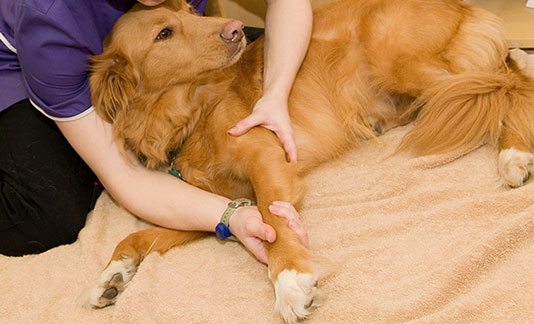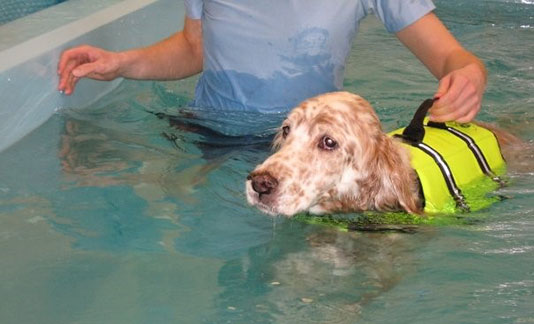Complementary therapies are methods of trying to treat illnesses and problems, which work alongside or instead of conventional medicine. The word ‘complementary’ refers to the fact that they may be used in addition to the conventional medicine advised by your veterinary surgeon. Some complementary therapies, such as acupuncture are based on older or traditional forms of medicine. Others such as physiotherapy and hydrotherapy, are more recent developments.
These therapies are often covered by your pet insurance as long as they are recommended by your vet and done through a veterinary referral. You insurer may also require that the therapist is a member of certain recognised organisations.
Physiotherapy
Physiotherapy is defined as the use of physical techniques for the treatment of injuries and movement dysfunction. In the world of human medicine, physiotherapy is already a valuable aid in the recovery of many conditions.
Physiotherapy is available for dogs, cats and other animals and is rapidly becoming recognised as a useful therapy for the prevention, cure and rehabilitation of animals following soft tissue injuries, fractures, trauma or surgery, and it helps greatly with the rehabilitation process. It is used to help reduce pain, swelling and inflammation and it provides optimum conditions to help restore normal movement and function and build strength and muscle mass.
Animal physiotherapists will use a variety of physical methods to restore movement and function to your pet’s body.
- Massage - helps mobilise and manipulate soft tissues and bones to decrease pain and stiffness and increase mobility
- Machines - such as ultrasound, laser, tens and electrical muscle stimulation, complement manual therapies and aid tissue repair and pain relief
- Application of heat or cold - to decrease pain and swelling, relax muscles, encourage blood and nutrients to an injured area speeding up the healing process
- Rehabilitative exercise - to strengthen, restore physical function and increase range of motion
Physiotherapy is highly versatile and many conditions can be treated and rehabilitated.
- Orthopaedic injuries such as Cruciate rupture, Fractures (broken bones) and Dislocations
- Orthopaedic problems such as Hip and Elbow dysplasia, Luxating patella and Osteochondrosis Dissecans
- Muscle and tendon injuries such as Sprains, Ruptures, Inflammation, Strains, Tension and Muscle atrophy
- Arthritic conditions such as Osteoarthritis, Rheumatoid Arthritis and Spondylosis
- Back injury and pain such as Spinal disk prolapse, Degenerative disk disease and after Spinal surgeries
- Neurological issues (nerves): such as Ataxia, Paralysis, Paresis and Nerve damage
- General fitness and mobility such as helping get your dog fit for agility or other activities
Physiotherapy Treatments
Methods and treatments will vary depending on the problem so the ways in which the physiotherapist will rehabilitate and reduce pain will be specifically tailored to each individual pet. The physiotherapist will look at the pet as a whole to decide on the best treatments and the first session is usually spent bonding with the pet to build up trust which is important for future sessions. We also find that many patients look forward to and really enjoy their physio sessions.
Massage: therapists use their hands to work on muscle and soft tissue. This improves movement and circulation, reduces and relieves pain and helps with relaxation. It also strengthens the muscles around the injured or painful area which can then provide greater support.
Exercise: This will involve programs of exercise for the pet and, depending on the problem, may be anything from tiny little stretches or flexing of the injured limb to full exercise programs that focus on fitness for agility or working dogs. Exercises may also involve the use of equipment to encourage stretching or bandaging techniques to make the pet more aware of certain parts of his or her body.

Other therapies can include
Pulsed Electromagnetic Field Therapy: This is used for many things including encouraging bone deposition, reducing the degenerating enzymes associated with Osteoarthritis, pain relief, reduction of swelling, increasing blood flow, soft tissue healing and stimulating endorphin release
Intrasound: used to free muscle adhesions, increase blood flow, relieve muscle spasm and knots
Static Magnets: These help increase circulation and are used for many ailments
Red Light Therapy: Can relieve muscle spasm, encourage endorphin release, increase blood flow, relax the patient and encourage wound healing whilst discouraging scar formation
Blue Light Therapy: This kills bacteria in a wound and so is used with the red light. It also helps other skin complaints heal
Thermo Therapy: Relives muscle spasm and increases blood flow
Cryo Therapy: Reduces inflammation
Stimulator: To help rebuild muscle
Neurotrac: Helps incontinent patients to regain bladder control
TENs machine: Is used for pain relief
Hydrotherapy
Hydrotherapy involves the use or application of water to promote or support healing and movement. The main advantage with hydrotherapy is that it is a weightless environment that encourages the use of the legs, and provides a range of movement that is not attainable with normal exercise. Animals that may refuse to put weight on, or even use a leg following surgery will typically use the leg without any discomfort in a hydrotherapy pool.

The warm water increases the circulation of blood to the muscles which relaxes them and helps to reduce swelling and/or pain around a limb or joint which allows for greater uninhibited movement
Hydrotherapy can be used to help a pet heal, recover and feel better in many ways including;
- Arthritis
- Hip and elbow dysplasia
- Paralysis
- Degenerative diseases involving bones or muscles
- Muscle wastage
- Weight loss
- After surgery i.e. cruciate repair, arthroscopy, hip replacement, spinal surgery and fracture repair
- Cardiovascular fitness and muscle strengthening exercises for working or agility dogs
Hydrotherapy is usually carried out in a specially designed pool with the therapist supporting the patient and encouraging certain types of movement or on an aquatic treadmill, in which the water height can be adjusted in order to control the amount of weight on the patient’s joints.
Referral for Physiotherapy or Hydrotherapy
Physiotherapy and hydrotherapy can help pets a great deal but please remember that it is important your pet should always be referred from your vet so that the therapist knows exactly what the condition is, what treatments have been given, or what surgery has been performed and any other problems your pet may have that could affect treatment.
Animal physiotherapists and hydrotherapists are not yet regulated by law which means that anyone could call themselves an a therapist without having any real knowledge. Therefore, we advise that you only visit a physiotherapist or hydrotherapist that has been recommended by your vet.